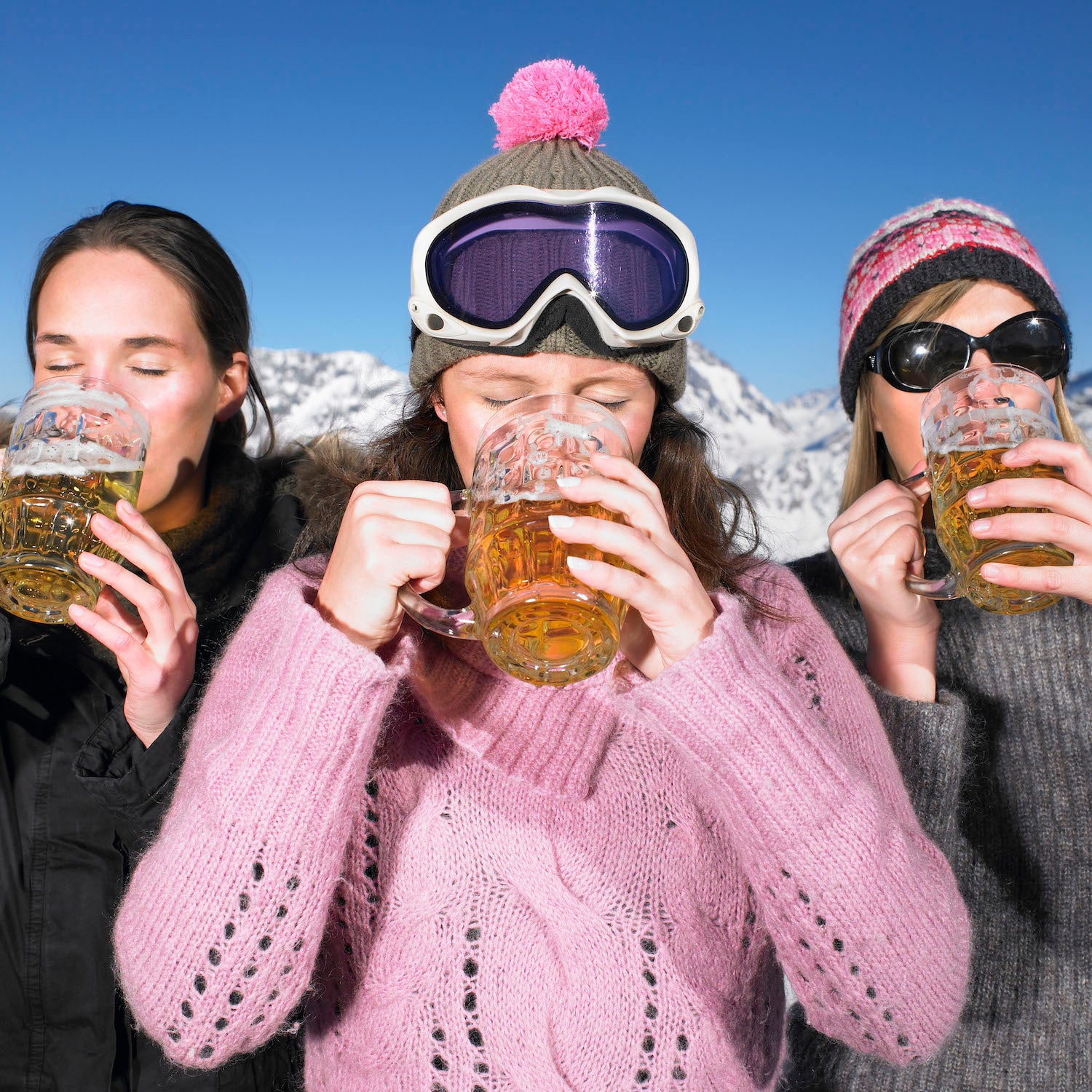Mountain sports are saturated with alcohol. Summit beers, lift beers, après ski, post-ride happy hours, whiskey around the campfire—some days it feels like you could drink from beginning to end of your favorite outdoor activity. But as public health officials issue warnings over alcohol and younger Americans report that they drink less than previous generations, it’s worth asking whether our outdoor adventures should include so much booze.
On January 3, U.S. Surgeon General Vivek Murthy called for cancer warnings to be added to alcoholic beverages, citing research that shows there are around 100,000 cancer cases and 20,000 cancer-related deaths due to alcohol every year. Drinking has also been to problems with the heart, liver, pancreas, gastrointestinal system, and immune system.
The advisory came at the beginning of Dry January, when many choose to give up alcohol for the month after indulging over the holidays. Even before Murthy’s report, U.S. alcohol sales were trending downward. But the percentage of American adults who drink has held relatively steady for decades. “It’s just so built into U.S. culture,” says Adrienne Webster, an addiction counselor based in Bozeman, Montana. “Alcohol is carcinogenic. It’s a neurotoxin. Those things are just facts. But we’re fed this B.S. that we should be doing it all the time. It’s probably the only substance that when you stop using it, people are like, ‘What? Why?’”
In my early twenties, I usually went skiing with a flask of Fireball or an unholy jungle juice of tequila and preworkout powder in my pocket. On hikes and bike rides, I would drink hard seltzers and beers that appeared from friends packs without much thought, and down a couple more in the parking lot at the end of the day. Then early last year, I started taking a medication that made me feel horribly sick if I had more than one drink in an evening. Suddenly, I had to get much more selective about my drinking habits—and cut back, a lot.
Coincidentally, several of my friends and adventure buddies were also rethinking their relationship with alcohol last year, for various reasons. As I began trying to be more intentional about when and what I was drinking, it was nice to compare notes with people who were going through the same process. Do I really want to be drunk right now, or is it just easy because everyone else is? If I just want a post-exercise treat, or to keep hanging out with everyone after the activity, could going out for ice cream or french fries be just as satisfying as stopping by a brewery?
I was lucky to have supportive friends, many of whom were in the same boat, as I navigated cutting back on alcohol. Not everyone does. “I see behind the scenes how many young people are trying to abstain, but nobody wants to talk about it, because there’s still so much stigma associated with it,” Webster says. “It’s still embarrassing.”
For Nick Pearson, the founder of the Colorado-based nonprofit Sober Outdoors, carving out a space in nature free of the stigma around sobriety has been critical for his recovery from alcohol use disorder. He spent years working in sales for outdoor brands and drinking a lot in the process, which led him to see firsthand just how thoroughly alcohol and the industry are enmeshed.
“When I finally got sober and went camping again, it was pretty nerve-wracking going with friends that drink,” Pearson says. “I was like, what am I gonna do while everyone’s sitting around the fire drinking? I wanted to create a space where people could experience the outdoors and not have to worry about alcohol being a part of the picture.”
Pearson quickly found that he wasn’t the only person who wanted a substance-free outdoor community. Roughly 900 people have attended the 40-plus outings Sober Outdoors has hosted since it was founded two years ago, and the group is starting to branch out into states beyond Colorado. That community has helped fortify Pearson’s resolve when he goes out with friends who still partake, and he hopes that the broader outdoor recreation culture will take some cues from the growing sober contingent.
“My biggest wish is that everyone takes a step back, looks at how substances impact them, and asks themselves, ‘How can we change to make the outdoors more inclusive?’ Because the sober audience is so much bigger than anyone even realizes,” Pearson says. “And Sober Outdoors is the proof in the pudding that you can have a great time without drinking—all these people that are hiking and camping and having a blast, without a beer in their hands the whole time.”
Personally, I’ve found that an ice-cold root beer or coke from the snowbank next to the car after a long ski tour hits just as hard as a regular beer. The hardest part was breaking the habit. Sometimes I’ll still take my favorite cider to savor at the top of a mountain, or split a beverage with a friend in the parking lot to celebrate a particularly stellar day on the slopes. But it’s a choice now, not a reflex.
Even if you feel comfortable with your current consumption habits, Pearson and Webster both have suggestions for ways everyone can help make a culture that’s welcoming and supportive of others’ sobriety: educate yourself, don’t make assumptions, and be inclusive.
“Sometimes people aren’t sure what to do when one of their friends stops drinking,” Webster says. “But just act normal and keep inviting your sober friends to things. They might not want to deal with being around alcohol, but it should be up to them.”
Pearson emphasized that you don’t always know what someone is going through, and statistically speaking, there’s a decent chance someone you know and recreate with has an unhealthy relationship with substance use. The National Institute of Health that 28.9 million, or just over one in ten, teenagers and adults in the U.S. had alcohol use disorder in 2023. When you include all substance use disorders, that number jumps to . “Someone may not tell you they’re trying to get sober, or they’ve got a problem with it, or want to cut back,” said Pearson. “But you need to just take people at their word. If they say, ‘No, I don’t want it,’ don’t push it.”
Occasionally, it’s still awkward or just a bummer when everyone I’m out with is drinking and I can’t. And I have no doubt that it’s much harder to navigate sobriety in mountain culture, in so many ways, for people in recovery from a substance use disorder than it is for someone like me. But for the most part, my newly sober-ish friends and I have all been struck by the degree to which our experiences in the mountains haven’t really changed this year. Your real friends won’t give you a hard time for not drinking, non-alcoholic beers truly are pretty good these days, and often french fries actually are the more enticing post-exercise treat.
I’m not asking you to stop drinking, or even telling you that you shouldn’t drink. But I think anyone who participates in outdoor sports, and anyone who drinks alcohol while they do, could probably stand to reflect on when and why they’re partaking. And we would probably all be better off if we asked ourselves what we’re doing, and what more we could do, to make sober people feel more welcome and included.


